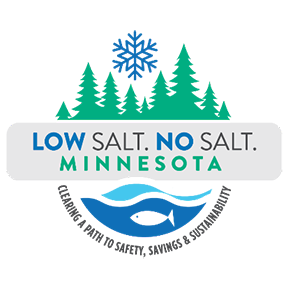Salt, also known as
chloride, threatens freshwater resources and the environment. Salt is used to maintain safe roads in the winter and for water softening. Once used, salt doesn't go away. It finds its way into lakes, streams and groundwater.
It only takes one teaspoon of salt to pollute five gallons of freshwater. Once salt dissolves in water, there is no easy way to remove it.
Dakota County has several water bodies with elevated chloride levels.
Thompson Lake in West St. Paul is listed as impaired for chloride. Portions of the
Vermillion River are considered “high risk" for chloride. The Minnesota Pollution Control Agency tracks
Minnesota's chloride conditions.
Reducing salt use is the best way to protect freshwater from chloride pollution.
 Low Salt No Salt – chloride reduction program
Low Salt No Salt – chloride reduction program
The Low Salt No Salt program encourages properties to reduce chloride use from deicing salt. The program offers support and resources to aid in adopting best practices on their property and to educate their community. Together, we can clear a path to safety, savings and sustainability.
Properties include:
- Faith-based communities
- Schools
- Homeowner, townhome and condo associations
If you are interested in participating in Low Salt No Salt, please contact
dclowsaltnosalt@co.dakota.mn.us.
Impacts of chloride
Aquatic species: High amounts of chloride are toxic to fish, insects and other aquatic species. Even low chloride levels can have a negative effect on aquatic life.
Plants & vegetation: Plants near roads and sidewalks can be exposed to road salt. Salt can inhibit growth and even kill plants and vegetation. Aquatic vegetation is also impacted by salty water.
Animals: Salt can be toxic when ingested by pets and wildlife. It can also irritate pets' paws.
Drinking water: Salt use has led to groundwater contamination is some areas of Minnesota. Chloride affects the taste of water and can mobilize heavy metals. More than 90 percent of Dakota County's drinking water comes from groundwater and is vulnerable to chloride pollution.
Infrastructure: Salt is incredibly corrosive. It can damage roads, bridges, sidewalks, vehicles, building exteriors, and water pipes.
How to help: Smart salting
The largest contributor of chloride in our environment is from deicing salt (42 percent). Follow these smart salting actions to use less salt while keeping paved surfaces safe:
-
Shovel first and early. The more snow and ice you remove, the less salt you will need.
-
Check the temperature. Most deicing salt is sodium chloride. It only works in temperatures at or above 15 degrees Fahrenheit. Switch to a different product or use sand/grit for traction.
-
Spread the salt. You only need 3 inches between salt grains for it to be effective. One 12-ounce cup of salt is enough to cover 10 sidewalk squares.
-
Sweep up any excess. Salt doesn't melt anything on bare pavement. Sweep it up and reuse it another time.
-
Store salt properly. Keep salt away from the elements. Store salt in a sealed container or use a waterproof covering.
If you hire a contractor for snow removal on your property, choose one certified by the
Minnesota Pollution Control Agency's Smart Salting certification program. If you are a winter maintenance professional, consider getting certified.
Water softening
When water is hard, it means it has a high mineral concentration. Most of Minnesota's groundwater is hard. Water softening removes minerals from the water by using sodium chloride. The sodium chloride eventually gets discharged to a wastewater treatment plant or a septic system.
Treatment plants and septic systems don't remove chloride, making water softening a significant contributor of chloride to the environment.
Consider these actions to reduce your chloride use from water softening:
-
Determine if you need a softener. Many water utilities already soften their water. Contact your water utility to find out your water hardness.
-
Upgrade your water softener. Consider using a softener that's demand-initiated rather than timer regenerated. Be sure to pick the right size softener, one that's too big or small is less efficient.
-
Not all water needs to be softened. Soften for indoor hot water needs, and for specific appliances, like water heaters.
-
Conserve water. Using less water reduces the need for softening. Learn more at
Dakota County Water Conservation.
-
Maintain your water softener. Follow the softener manual and have it inspected by a professional.